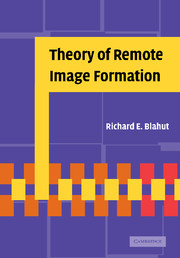Book contents
- Frontmatter
- Contents
- Preface
- Acknowledgements
- 1 Introduction
- 2 Signals in one dimension
- 3 Signals in two dimensions
- 4 Optical imaging systems
- 5 Antenna systems
- 6 The ambiguity function
- 7 Radar imaging systems
- 8 Diffraction imaging systems
- 9 Construction and reconstruction of images
- 10 Tomography
- 11 Likelihood and information methods
- 12 Radar search systems
- 13 Passive and baseband surveillance systems
- 14 Data combination and tracking
- 15 Phase noise and phase distortion
- References
- Index
2 - Signals in one dimension
Published online by Cambridge University Press: 19 August 2009
- Frontmatter
- Contents
- Preface
- Acknowledgements
- 1 Introduction
- 2 Signals in one dimension
- 3 Signals in two dimensions
- 4 Optical imaging systems
- 5 Antenna systems
- 6 The ambiguity function
- 7 Radar imaging systems
- 8 Diffraction imaging systems
- 9 Construction and reconstruction of images
- 10 Tomography
- 11 Likelihood and information methods
- 12 Radar search systems
- 13 Passive and baseband surveillance systems
- 14 Data combination and tracking
- 15 Phase noise and phase distortion
- References
- Index
Summary
We shall study waveforms in one dimension in this chapter and waveforms in two dimensions in the next chapter. We shall call these waveforms one-dimensional signals and two-dimensional signals, respectively.
A waveform that is used by a surveillance system to probe the environment is usually a function of the single variable — time. The collected sensor data will be a set of one or more of such one-dimensional waveforms. However, the environment usually is a two-dimensional or three-dimensional spatial region on which is defined a two-dimensional or three-dimensional signal of interest. Thus the computational task of image formation frequently consists of estimating an unknown two-dimensional or three-dimensional function when given a set of one-dimensional signals as the measured data.
Every waveform of finite energy is associated with another function, known as its Fourier transform, that describes a decomposition of the waveform into an infinite number of sinusoids. The Fourier transform constitutes an alternative representation of the function in the frequency domain. The frequency-domain representation is often much easier to work with than the original time-domain representation of the waveform. The Fourier transform is so pervasive in our studies that, in time, we shall scarcely be able to decide whether the original waveform or its Fourier transform is the more fundamental concept. For this reason, it is important to develop good intuition regarding the Fourier transform.
- Type
- Chapter
- Information
- Theory of Remote Image Formation , pp. 29 - 66Publisher: Cambridge University PressPrint publication year: 2004



